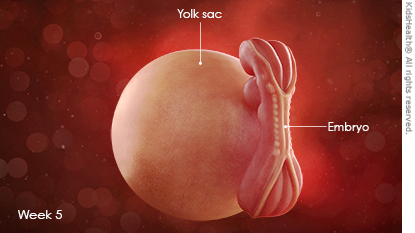- Home
- Humana Medicaid
- Kentucky Medicaid
- Medicaid extras
- Health and wellness
- Parents Home
- Para Padres
- A to Z Dictionary
- Allergy Center
- Asthma
- Cancer
- Diabetes
- Diseases & Conditions
- Doctors & Hospitals
- Emotions & Behavior
- First Aid & Safety
- Flu (Influenza)
- Food Allergies
- General Health
- Growth & Development
- Heart Health & Conditions
- Homework Help Center
- Infections
- Newborn Care
- Nutrition & Fitness
- Play & Learn
- Pregnancy Center
- Preventing Premature Birth
- Q&A
- School & Family Life
- Sports Medicine
- Teens Home
- Para Adolescentes
- Asthma
- Be Your Best Self
- Body & Skin Care
- Cancer
- Diabetes
- Diseases & Conditions
- Drugs & Alcohol
- Flu (Influenza)
- Homework Help
- Infections
- Managing Your Weight
- Medical Care 101
- Mental Health
- Nutrition & Fitness
- Q&A
- Safety & First Aid
- School, Jobs, & Friends
- Sexual Health
- Sports Medicine
- Stress & Coping
Pregnancy Calendar: Week 5
Your Baby's Development
Until now, the embryo has been a mass of cells. But now a distinct shape begins to  form. The neural tube (which will become the spinal cord and brain) runs from the top to the bottom of the embryo. A bulge in the center of the embryo will develop into your baby's heart.
form. The neural tube (which will become the spinal cord and brain) runs from the top to the bottom of the embryo. A bulge in the center of the embryo will develop into your baby's heart.
At this time, the placenta develops. It's through the placenta and its fingerlike projections, called chorionic villi, that an embryo gets nourishment from its mother.

Your Body
 Even if nausea hasn't hit you yet, you'll want to steer clear of some foods. Foodborne illnesses, such as listeriosis and toxoplasmosis, may cause birth defects or even miscarriage.
Even if nausea hasn't hit you yet, you'll want to steer clear of some foods. Foodborne illnesses, such as listeriosis and toxoplasmosis, may cause birth defects or even miscarriage.
Here are some foods to avoid:
- soft, unpasteurized cheeses (often advertised as "fresh") such as feta, goat, Brie, Camembert, and blue cheese
- unpasteurized milk, juices, and apple cider
- raw eggs or foods containing raw eggs, including mousse and tiramisu
- raw or undercooked meats, fish, or shellfish
- processed meats such as hot dogs and deli meats (if you eat them, they should be well-cooked)
- fish high in mercury, including shark, swordfish, king mackeral, or tilefish
Toxoplasmosis also can spread from soiled cat litter boxes, so try to have someone else clean the litter box during your pregnancy.

© 1995- The Nemours Foundation. KidsHealth® is a registered trademark of The Nemours Foundation. All rights reserved.
Images sourced by The Nemours Foundation and Getty Images.